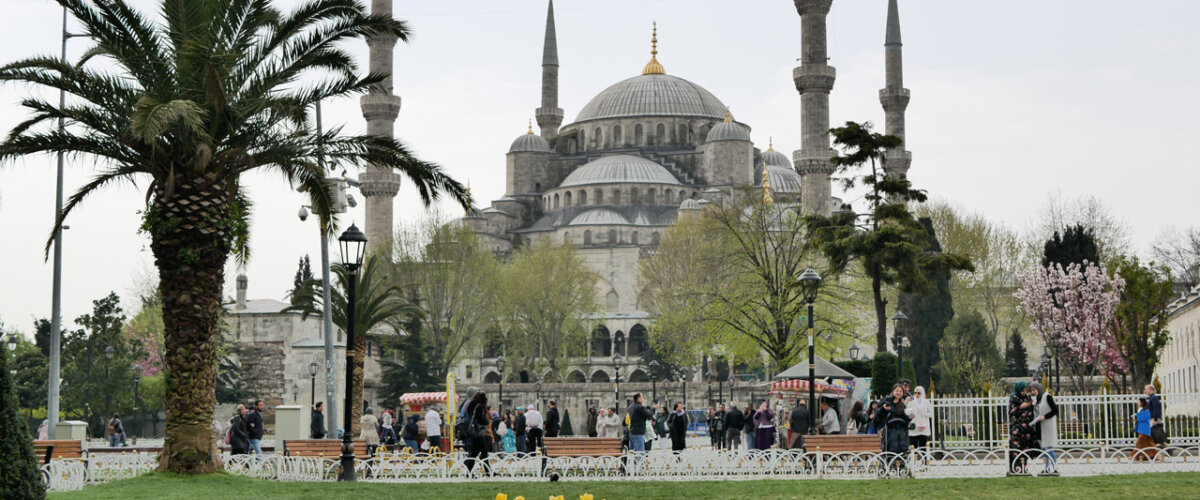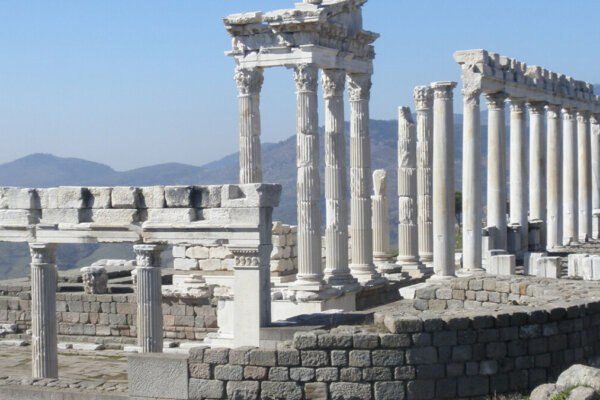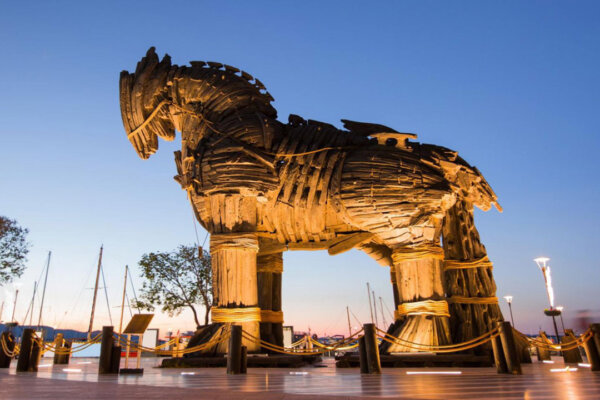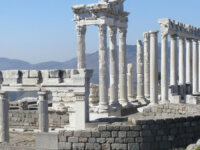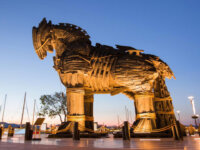TURKEY – The Sultan Ahmed Mosque, also known as the Blue Mosque, is one of the most magnificent Ottoman mosques in Turkey. Its history dates back almost 500 years, making it a significant landmark in the country’s cultural and religious heritage.
Commissioned by Sultan Ahmed I in the early 17th century, this grand mosque was designed by the renowned architect Sedefkar Mehmed Ağa. It took seven years to complete and was opened for worship in 1616. The mosque’s name, “Blue Mosque,” comes from the stunning blue tiles that adorn its interior walls, creating a mesmerizing effect.
The architectural style of the Blue Mosque is a fusion of Byzantine and Islamic elements, showcasing the influence of both cultures on the Ottoman Empire. The exterior boasts six towering minarets, while the interior features a central dome surrounded by smaller domes and semi-domes. The intricate calligraphy and geometric patterns adorning the walls and ceilings are a testament to the skilled craftsmanship of the artisans who worked on this masterpiece.
Aside from its architectural beauty, the Blue Mosque is also a significant place of worship for Muslims. It can accommodate up to 10,000 worshippers at a time and is still an active mosque today. Visitors can witness the daily prayers and experience the peaceful atmosphere inside the mosque.
The Sultan Ahmed Mosque is not only a symbol of religious devotion but also a symbol of the Ottoman Empire’s power and wealth during its reign. It has withstood the test of time, surviving natural disasters and wars, and remains a must-visit destination for tourists from all over the world. Its grandeur and historical significance make it a true gem of Turkey’s cultural heritage.
Readmore: Traveling during Ramadan in Turkey
Overview of the Sultan Ahmed Mosque
The Sultan Ahmed Mosque, also known as the Blue Mosque, is a historic mosque located in Istanbul, Turkey. It was built between 1609 and 1616 during the reign of Sultan Ahmed I, and it is considered one of the greatest masterpieces of Ottoman architecture.
The mosque is famous for its stunning blue tiles, which adorn the interior walls and give it its nickname. It also features six minarets, making it one of the few mosques in the world to have this many. The central dome, which is surrounded by smaller domes, is an impressive sight and adds to the grandeur of the mosque.
https://www.instagram.com/reel/C0vnP0rK35U/
Aside from its architectural beauty, the Sultan Ahmed Mosque is also significant for its religious importance. It is still an active place of worship, with daily prayers being held for Muslims. Non-Muslim visitors are also welcome to visit the mosque, but they must follow certain rules, such as removing their shoes and covering their heads.
Overall, the Sultan Ahmed Mosque is a must-see attraction for anyone visiting Istanbul. Its rich history, stunning architecture, and religious significance make it a truly remarkable landmark that continues to draw visitors from all over the world. The Sultan Ahmed Mosque, also known as the Blue Mosque, is considered a royal masterpiece of Islamic architecture in Istanbul, symbolizing the grandeur of the Ottoman era.
Recognized by UNESCO as a World Heritage Site, this mosque in Turkey is a major attraction for tourists and followers of Islam alike, earning its vibrant nickname, the Blue Mosque, due to the countless blue tiles adorning its interior walls.
Located in the historic Sultanahmet Square, the Blue Mosque stands out as a gem of architectural beauty amidst the bustling city of Istanbul. Its intricate design and stunning details make it a must-see for anyone visiting the city. The mosque was commissioned by Sultan Ahmed I in the early 17th century and took seven years to complete. Its unique blend of Byzantine and traditional Islamic elements makes it a one-of-a-kind structure.
Google Maps: https://maps.app.goo.gl/FakDZj15Fhj5DdaB8
Stepping inside the Blue Mosque, visitors are greeted with a breathtaking sight of over 20,000 handmade ceramic tiles, each carefully placed to create intricate patterns and designs. The high ceilings and spacious prayer hall add to the overall sense of grandeur and magnificence.
Aside from its architectural significance, the Blue Mosque also holds great religious importance for Muslims. It is still an active place of worship, with daily prayers being held within its walls. Non-Muslim visitors are welcome to enter the mosque outside of prayer times, but are asked to dress modestly and respect the sacred space.
Overall, the Blue Mosque is a true testament to the rich history and cultural heritage of Istanbul. Its majestic presence and stunning features continue to captivate visitors from all around the world, making it a must-visit destination for anyone exploring the city.
The architectural vision of Sedefkar Mehmed Ağa
Designed by the architectural genius Sedefkâr Mehmed Ağa, the Blue Mosque was commissioned by Sultan Ahmed I. Its construction began in 1609 and was completed in 1616, resulting in a complex known as külliye. This complex includes the main mosque, the tomb of Sultan Ahmed I, a soup kitchen, and a madrasah or Islamic school.
The Blue Mosque is one of the most iconic landmarks in Istanbul, Turkey. Its name comes from the stunning blue tiles that adorn its interior walls, creating a mesmerizing effect. The mosque’s design is a fusion of Ottoman and Byzantine architecture, with its six minarets and cascading domes dominating the city skyline.
The construction of the Blue Mosque was a grand undertaking, involving thousands of workers and artisans. It was built on the site of the ancient Hippodrome, which was the center of Byzantine Constantinople. The mosque’s location was carefully chosen to symbolize the Ottoman Empire’s dominance over the former Byzantine capital.
The külliye surrounding the Blue Mosque was also an essential aspect of its construction. These additional buildings served not only religious but also social and educational purposes. The soup kitchen provided free meals to the poor, while the madrasah offered education to students in Islamic theology, law, and science.
Today, the Blue Mosque continues to be a significant place of worship for Muslims and a popular tourist attraction. Visitors can marvel at its intricate architecture, admire the beautiful calligraphy and tile work, and experience the peaceful atmosphere inside the mosque. It is a testament to the rich history and cultural heritage of Istanbul and a must-visit for anyone traveling to this vibrant city.
The historical journey of the Sultan Ahmed Mosque.
Constructed during the Ottoman-Safavid War (17th century).
Built in the 17th century, the Blue Mosque was a response to the defeat of the Ottoman Empire in the Ottoman-Safavid War (1603-1618).
Sultan Ahmed I, seeking to restore the glory of the empire, envisioned a magnificent architectural structure to showcase the might of the Ottomans. The Blue Mosque was strategically located at the Hippodrome of Constantinople, a public square in Istanbul.
The construction of the Blue Mosque was not only a symbol of the Ottoman’s power and resilience, but also a testament to their religious devotion. The mosque was designed by the famous architect Sedefkar Mehmed Agha, who incorporated elements from both Byzantine and Islamic architecture, creating a unique blend of styles.
The grandeur of the Blue Mosque is evident in its intricate details and impressive size. It boasts six minarets, which was an unprecedented feature at the time, and its interior is adorned with over 20,000 handmade ceramic tiles in shades of blue, giving the mosque its name.
The Blue Mosque has become one of the most iconic landmarks in Istanbul, attracting visitors from all over the world. Its stunning beauty and historical significance make it a must-see for anyone visiting the city. Today, the mosque continues to serve as a place of worship for Muslims, while also serving as a popular tourist attraction.
The difficult financial and credibility situation of the empire.
The construction of the Blue Mosque incurred significant costs, which were usually funded through war spoils. However, due to the losses suffered during the war, Sultan Ahmed I personally financed the construction of the mosque from the royal treasury.
Located on the site of the former palace of the Byzantine emperors, the Blue Mosque quickly became the primary mosque of the Ottoman royalty. Its grandeur and intricate design served as a symbol of the power and wealth of the Ottoman Empire. The construction of the mosque was also seen as a way for Sultan Ahmed I to solidify his authority and establish himself as a great ruler.
The Blue Mosque, also known as the Sultan Ahmed Mosque, is an architectural masterpiece that combines elements of both Byzantine and Islamic styles. Its six minarets, cascading domes, and intricate tile work make it one of the most iconic landmarks in Istanbul, Turkey.
Despite its opulence, the construction of the Blue Mosque was not without controversy. Some criticized Sultan Ahmed I for using funds from the royal treasury, which could have been used for other purposes such as improving the lives of his people. Others saw it as a display of extravagance and questioned the necessity of such a grand mosque.
However, despite the criticisms, the Blue Mosque remains a testament to the rich history and cultural heritage of the Ottoman Empire. It continues to attract visitors from all over the world who are in awe of its beauty and significance. Today, it stands as a symbol of the enduring legacy of Sultan Ahmed I and his contribution to the development of Istanbul as a major center of Islamic art and architecture.
Tourist center and religious center.
Known as the Sultan Ahmet Mosque by locals, the Blue Mosque serves as both a place of worship and a popular tourist attraction. It is a significant landmark in Istanbul, Turkey, and draws visitors from all over the world. The mosque is named after Sultan Ahmet I, who commissioned its construction in the early 17th century.
The Blue Mosque is not only a symbol of religious importance but also a masterpiece of Islamic architecture. Its impressive design features six minarets, a large central dome, and cascading domes and semi-domes. The interior is adorned with intricate hand-painted blue tiles, giving the mosque its famous nickname.
Aside from its stunning architecture, the Blue Mosque holds great cultural significance for Muslims. It is a place of reverence and prayer, attracting worshippers from different parts of the world. Many notable figures and Muslim leaders make regular visits to the mosque, adding to its prestige and spiritual significance.
Located near the Grand Bazaar, one of the oldest and largest covered markets in the world, the Blue Mosque’s location adds to its appeal as a top tourist destination in Turkey. Visitors can easily combine a visit to the mosque with a shopping trip to the bustling bazaar, making it a must-see spot on any itinerary.
In addition to its religious and cultural significance, the Blue Mosque also offers a glimpse into the rich history and heritage of Istanbul. It has stood the test of time, surviving earthquakes and wars, and remains a symbol of the city’s past and present. Its grandeur and beauty continue to captivate visitors, making it a must-visit attraction for anyone traveling to Turkey.
The fusion of architecture: Ottoman and Byzantine styles.
The architectural style of the Blue Mosque draws inspiration from the design of Ottoman mosques from centuries before. It seamlessly combines traditional Islamic architecture with influences from Byzantine, evident through the borrowed elements from the nearby Hagia Sophia.
Under the guidance of the renowned Sinan, Sedefkâr Mehmed Ağa created a monumental structure that exudes grandeur, scale, and the essence of a palace fit for the greatness of Allah. The mosque’s design is a perfect fusion of various architectural elements, showcasing the mastery of its creators in blending different styles to create a unique and awe-inspiring masterpiece.
https://www.instagram.com/p/C0uS620I-BL/
The influence of Byzantine architecture can be seen in the use of domes, arches, and intricate geometric patterns, while the traditional Islamic elements are reflected in the minarets, prayer hall, and courtyard. This harmonious blend of styles creates a sense of unity and balance, reflecting the peaceful coexistence of different cultures and religions in Istanbul.
Moreover, the Blue Mosque’s design also pays homage to the famous Hagia Sophia, which was once a church and later converted into a mosque. The use of cascading domes, semi-domes, and the central dome is reminiscent of the iconic features of Hagia Sophia, showcasing the influence it had on the architects of the Blue Mosque.
Overall, the Blue Mosque stands as a testament to the rich history and cultural diversity of Istanbul. Its architectural style not only reflects the artistic and engineering skills of its creators but also serves as a symbol of harmony and tolerance between different civilizations.
3 notable features of the Blue Mosque.
The Blue Mosque, also known as the Sultan Ahmed Mosque, is not just a mere architectural structure; it is a testament to the grandeur and finesse of Ottoman architecture and a timeless symbol of devotion at the heart of Istanbul. With its stunning blue tiles, six towering minarets, and magnificent central dome, the mosque stands as a true masterpiece in the city’s skyline.
One of the most striking features of the Blue Mosque is its interior, adorned with approximately 20,000 hand-painted blue tiles in the unique Iznik ceramic style. These tiles depict 60 different patterns of tulip flowers, adding a touch of elegance and beauty to the space. The interior is also illuminated by 260 stained glass windows, creating a mesmerizing play of light and color within the mosque. Moreover, the mihrab, or prayer niche, is positioned towards the direction of Mecca, making it a focal point for worshippers during prayers.
Another remarkable aspect of the Blue Mosque is its six minarets, a rare sight among mosques in Turkey. Three towering minarets stand on the left side of the mosque, while the other three stand on the right. Each minaret reaches a height of 210 feet and has two or three balconies. Five times a day, a muezzin climbs up the narrow spiral staircase to one of these balconies to announce the call to prayer, adding a sense of spiritual ambiance to the surroundings.
The central dome of the Blue Mosque is another awe-inspiring feature. Surrounded by four main domes and eight smaller ones, the central dome reaches a height of 141 feet. It is adorned with 28 windows, allowing natural light to flood the interior and creating a breathtaking architectural spectacle. The half-domes that support the central dome add to the overall grandeur of the mosque.
In conclusion, the Blue Mosque is not just a place of worship but a true work of art that reflects the rich history and culture of Istanbul. Its intricate details, stunning architecture, and spiritual significance make it a must-visit destination for anyone traveling to Turkey.
Readmore: The Great Mosque of Hagia Sophia in Turkey – Everything You Need to Know.

